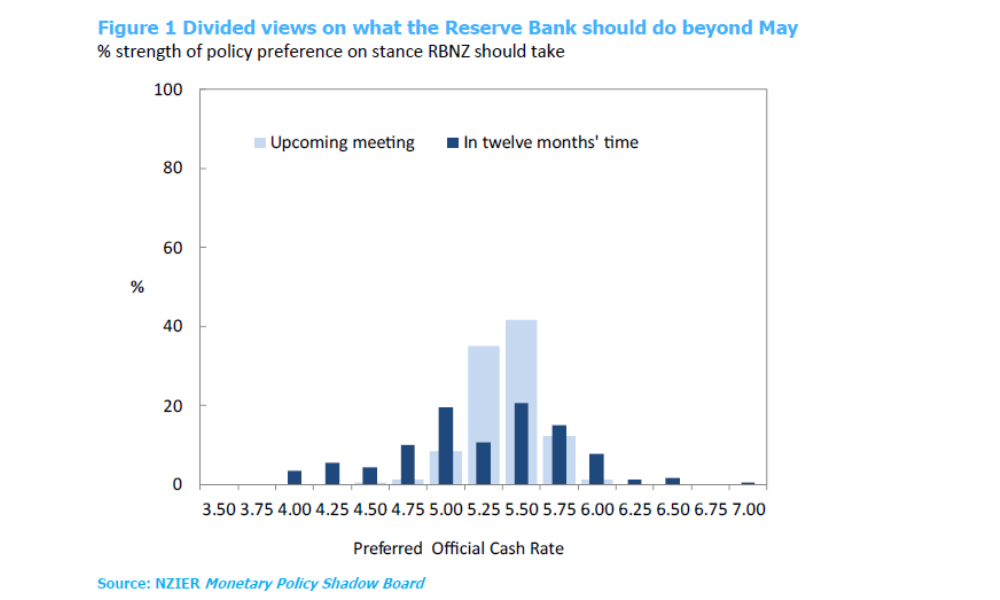Official cash rate decision happening on Wednesday

Leaders across different industries are divided over whether the Reserve Bank should hike the official cash rate this month, according to an independent economics consultancy firm report.
The official cash rate, currently 5.25%, has increased 5% (500 basis points) since October 2021.
Ahead of the Reserve Bank’s May Monetary Policy Statement and OCR announcement on May 24, bank economists are expecting either a quarter or a half a percentage point hike.
On Monday, the New Zealand Institute of Economic Research (NZIER) said the largest number of its Shadow Board members held the view that domestic inflation pressures remain high, therefore a 0.25% increase in the official cash rate to 5.50% was warranted.
The NZIER Shadow Board is a range of NZIER members representing different industry sectors and provides regular commentary on Reserve Bank interest rate increases. Participants put a percentage preference on each policy action, and the average of these preferences provides a Shadow Board view ahead of each monetary policy decision.
At more than 40%, the biggest portion of members viewed a 0.25% hike to 5.5% as reasonable at the May meeting. The second-largest portion of its remaining members recommended that the central bank “keep the OCR at 5.25%”.

One member noted that household inflation measures were “already heading in the right direction” and that “monetary policy takes time to have an impact”. Another member was concerned about the continued decline in profitability for businesses as consumers were increasingly more cautious about spending.
Inflation eased to 6.7% over the year to March, the RBNZ saying in its last review on April 5 that the Committee agreed that maintaining the current level of lending rates was necessary to reduce inflation and inflation expectations to its target range.
Looking ahead
Shadow Board members were also divided on where the official cash rate should be in a year’s time, reflecting their differing concerns about the economic outlook over the coming year.
Recent developments, such as weaker government tax revenue and consumer spending, and continued declines in business profitability, pointed to a slowing in the New Zealand economy, one member said.
Two members pointed out the potential impact of rising net migration inflows on inflation, along with any new fiscal stimulus in the 2023 Budget, which the Reserve Bank should “keep their eyes on”.
Among the Shadow Board members not in favour of raising the OCR was University of Otago senior lecturer of economics Dennis Wesselbaum. He noted that the consumer price index (CPI) and the producers price index (PPI) were falling, mortgage repayment liabilities were increasing, and that jobseeker support and hardship assistance had increased.
“CPI is still outside the target range, but median household inflation expectations are moving in the right direction,” Wesselbaum said in the report. “Given the lags of monetary policy, I would stop increasing the OCR.”
Boffa Miskell chief executive Kerry Gupwell said that while overall inflation seemed to have peaked, domestic (non-tradeable inflation) remained a concern – and that Cyclone Gabrielle hadn’t helped.
“On balance, I think another 25 basis points increase in the OCR is warranted, although there are signs that companies and households are starting to tighten their belts,” Gupwell said.
On Monday, Westpac said it had forecasted a 0.25% hike in May, followed by two further 0.25% hikes in July and August, taking the OCR to 6%.
Kiwibank is also forecasting a 0.25% rise and a cash rate peak of 5.50%. The bank also highlights the risk of a 0.50% move and a cash rate peak of 5.75%.
Post-Budget, ASB Bank is forecasting a final 0.50% rise this month, with the expectation that the RBNZ would flag the risk of a further hike.
The RBNZ will announce its decision on interest rates on Wednesday.

